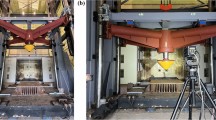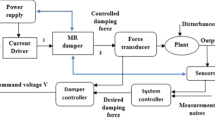Abstract
The ability to design a size reduction system prior to full scale experiments and to optimize existing systems has long been a goal of designers. Such a design and optimization could be achieved by correctly simulating any system under any operating condition. In this paper we present a new and innovative procedure to implement empirical comminution functions into DEM–CFD simulations. The paper is focused on the implementation procedures and not the DEM/CFD simulations, which deserve full attention. Therefore, this paper is not aimed to study any specific mill. The comminution functions include: initial strength distribution, selection function, breakage function and fatigue function. First, the traditional comminution functions (strength distribution, selection and breakage functions) and the recently investigated fatigue function are briefly described and modified. Then a procedure for implementing the functions into a DEM–CFD model or any other source to provide impact velocities and number of impacts, is described in detail. The implementation involves converting the probability comminution functions into individual particle properties by a random method and then converting the velocity dependent comminution functions into strength dependent ones. In this way, and mainly owing to the use of the fatigue function (which defines the weakening of those particles that are not breaking), a real size reduction system, in which each particle is subjected to multiple impacts at various velocities can be simulated. Three case studies for multiple impact conditions at the same average velocity (several impacts at the same velocity, various velocities at each impact and randomly selected velocities) are presented and analyzed in order to confirm qualitatively the procedure, although the comminution functions need to be further quantitatively modified. It should be emphasized that although the new procedure presents a step towards the final goal, some limitations do exist and some questions remain open.
Similar content being viewed by others
Abbreviations
- a :
-
empirical parameter for the breakage function (-)
- b :
-
fragment frequency ratio for particle diameter d (-)
- B :
-
cumulative volumetric/mass breakage function (-)
- d :
-
particle size (m)
- d i :
-
undersize particle diameter (m)
- d j :
-
fragment particle diameter (m)
- d max :
-
largest fragment particle size (m)
- d mi :
-
average particle diameter of the specific size fraction (m)
- d min :
-
smallest fragment particle size (m)
- D v :
-
wideness of impact selection function (-)
- D v1, D v2 :
-
empirical constants depending on the material, Eq.(4) (-)
- D σ :
-
wideness of crushing strength distribution (-)
- f 1, f 2, f 3 :
-
non-dimensional groups, Eq. (6) (-)
- k :
-
constant value depending on the material, Eq. (9) (-)
- n :
-
impact number (-)
- n i :
-
number of particles in group I (-)
- n T :
-
number of all fragments (-)
- N :
-
cumulative numbered breakage function (-)
- N p :
-
empirical constant depending on the material, Eq. (4) (-)
- S c :
-
cumulative probability for crushing, compression selection function (-)
- S i :
-
impact selection function (-)
- v :
-
impact velocity (m/s)
- v av :
-
average velocity (m/s)
- v n :
-
empirical constant depending on the material, Eq. (4) (m/s)
- W i :
-
fragment weight between two sieves (kg)
- W T :
-
total sample weight (kg)
- ρ p :
-
particle density (kg/m3)
- σ :
-
compression stress (N/m2)
- σ c :
-
crushing stress (N/m2)
- σ m :
-
crushing strength of mother particle (N/m2)
- \({\sigma_{m}^{\prime}}\) :
-
strength of the particles after applying the loading cycle (N/m2)
- σ r :
-
equivalent compression stress due to the impact velocity (N/m2)
- σ*:
-
ratio between equivalent compression stress and crushing strength (-)
- 50:
-
median
References
Vogel L., Peukert W.: Characterisation of grinding-relevant particle properties by inverting a population balance model. Part. Part. Syst. Character. 19, 149–157 (2002). doi:10.1002/1521-4117(200207)19:3<149::AID-PPSC149>3.0.CO;2-8
Kalman H., Hubert M., Grant E., Petukhov Y., Haim M.: Fatigue behavior of impact comminution and attrition units. Powder Technol. 146, 1–9 (2004). doi:10.1016/j.powtec.2004.07.011
Vogel L., Peukert W.: From single particle impact behaviour to modelling of impact mills. Chem. Eng. Sci. 60, 5164–5176 (2005). doi:10.1016/j.ces.2005.03.064
Bilgili E., Scarlett B.: Population balance modeling of non-linear effects in milling processes. Powder Technol. 153, 59–71 (2005). doi:10.1016/j.powtec.2005.02.005
Austin L.G.: A preliminary simulation model for fine grinding in high speed hammer mills. Powder Technol. 143–144, 240–252 (2004)
Kalman H., Goder D.: Design criteria for particle attrition. Adv. Powder Technol. 9, 153–167 (1998)
Han T., Kalman H., Levy A.: Theoretical and experimental study on multi-compression breakage of particles. Adv. Powder Technol. 14, 605–620 (2003). doi:10.1163/156855203322448372
Petukhov Y., Kalman H.: Empirical breakage ratio of particles due to impact. Powder Technol. 143–144C, 160–169 (2004)
Han T., Petukhov Y., Levy A., Kalman H.: Theoretical and experimental study of multi-impact breakage of particles. Adv. Powder Technol. 17, 135–157 (2006). doi:10.1163/156855206775992328
Powell M.S., McBride A.T.: What is required from DEM simulations to model breakage in mills?. Miner. Eng. 19, 1013–1021 (2006). doi:10.1016/j.mineng.2006.03.009
Shvartsman, M.: Fatigue function for population balance model. M.Sc. Thesis, Ben-Gurion University of the Negev (2008)
Author information
Authors and Affiliations
Corresponding author
Rights and permissions
About this article
Cite this article
Kalman, H., Rodnianski, V. & Haim, M. A new method to implement comminution functions into DEM simulation of a size reduction system due to particle-wall collisions. Granular Matter 11, 253–266 (2009). https://doi.org/10.1007/s10035-009-0140-8
Received:
Published:
Issue Date:
DOI: https://doi.org/10.1007/s10035-009-0140-8




